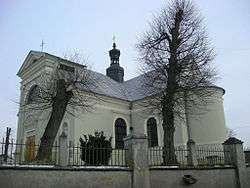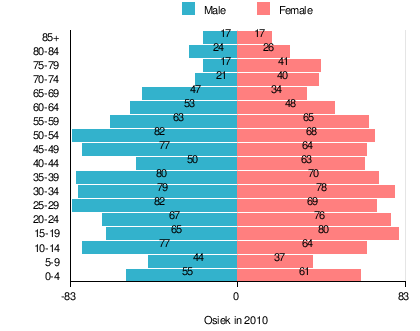Osiek, Świętokrzyskie Voivodeship
Osiek [ˈɔɕek] (![]()
Osiek | |
|---|---|
Town | |
 Church of St. Stanislaus in Osiek | |
 Coat of arms | |
 Osiek | |
| Coordinates: 50°31′12″N 21°26′34″E | |
| Country | |
| Voivodeship | Świętokrzyskie |
| County | Staszów |
| Gmina | Osiek |
| Town rights | 1430 |
| Area (through the years 2008-2010)[1] | |
| • Total | 17.43 km2 (6.73 sq mi) |
| Elevation | 180 m (590 ft) |
| Population (31 December 2010 at Census)[1] | |
| • Total | 2,001 |
| • Density | 110/km2 (300/sq mi) |
| Time zone | UTC+1 (CET) |
| • Summer (DST) | UTC+2 (CEST) |
| Postal code | 28-221 |
| Area code(s) | +48 15 |
| Car plates | TSZ |
Osiek is one of the oldest towns in the region. According to legends, in 1020 King Bolesław Chrobry presented the village called Ossziek to the Benedictine Monastery at Święty Krzyż. In 1253 the name of the village was spelled Ossek. It belonged to Princes of Sandomierz, and had its own marketplace. In 1270, Osiek was the property of Prince Bolesław V the Chaste. Its residents took advantage of a favorable location, along a merchant route from Kraków, through Sandomierz and Lublin, to the Grand Duchy of Lithuania. Many Piast dynasty princes would stop here during their trips across the country. Osiek most likely was a fortified gord, and in the mid-14th century, King Kazimierz Wielki built (or strengthened) a local castle.
Osiek was burned in the Mongol invasion of Poland, but the village was quickly rebuilt. In 1430, King Władysław Jagiełło granted it the Magdeburg rights, allowing the town to organize weekly markets on Wednesdays. Osiek was a private town, owned by local szlachta families. It prospered during the Polish Golden Age, when it was part of the Sandomierz Voivodeship. In the second half of the 16th century, its population amounted to 1,000, with a number of guilds, such as bakers, butchers, blacksmiths, tailors, potmakers, and millers. Osiek had 100 houses, and a wooden parish church of St. Stanisław. The decline of the town was brought by the Swedish invasion of Poland (1655–1660). Like almost all Lesser Poland’s towns, Osiek was ransacked and burned, and never recovered from the destruction. Until the Partitions of Poland, it remained within borders of the Sandomierz Voivodeship, and since 1815, it was part of the Russian-controlled Congress Poland. The town further declined in the 19th century, losing its charter in 1869, after January Uprising.
Osiek was destroyed in both world wars, during the Invasion of Poland (September 1939), retreating units of the Polish Army fought here a battle with the Wehrmacht, in which app. 100 Poles died. As a result of World War I and World War II destruction, there are no other historic buildings in Osiek, except for the parish church.
Demographics
According to the 2011 Polish census, there were 2,001 people residing in Osiek, of whom 50% were male and 50% were female. In the town, the population consisted of 21.2% inhabitants under the age of 18; 38.6% between the age of 18 and 44; 23.6% from 45 to 64; and 16.6% residents who were 65 years of age or older.[1]

| SPECIFICATION | Measure unit |
POPULATION (by sex in 2010) | |||||||||||||||||
|---|---|---|---|---|---|---|---|---|---|---|---|---|---|---|---|---|---|---|---|
| TOTAL | Males | Females | |||||||||||||||||
| I. | TOTAL | person | 2,001 | 1,000 | 1,001 | ||||||||||||||
| — | of which in | % | 100 | 50 | 50 | ||||||||||||||
| 1. | BY AGE GROUP | ||||||||||||||||||
| A. | At pre-working age | person | 425 | 215 | 210 | ||||||||||||||
| — | of which in | % | 21.2 | 10.7 | 10.5 | ||||||||||||||
| B. | At working age, grand total | person | 1,244 | 659 | 585 | ||||||||||||||
| — | of which in | % | 62.2 | 33 | 29.2 | ||||||||||||||
| a. | at mobile working age | person | 772 | 384 | 388 | ||||||||||||||
| — | of which in | % | 38.6 | 19.2 | 19.4 | ||||||||||||||
| b. | at non-mobile working age | person | 472 | 275 | 197 | ||||||||||||||
| — | of which in | % | 23.6 | 13.8 | 9.8 | ||||||||||||||
| C. | At post-working age | person | 332 | 126 | 206 | ||||||||||||||
| — | of which in | % | 16.6 | 6.3 | 10.3 | ||||||||||||||
| SPECIFICATION | Measure unit |
POPULATION (by age group in 2010) | |||||||||||||||||||||||
|---|---|---|---|---|---|---|---|---|---|---|---|---|---|---|---|---|---|---|---|---|---|---|---|---|---|
| TOTAL | 0-4 | 5-9 | 10-14 | 15-19 | 20-24 | 25-29 | 30-34 | 35-39 | 40-44 | 45-49 | 50-54 | 55-59 | 60-64 | 65-69 | 70-74 | 75-79 | 80-84 | 85 + | |||||||
| I. | TOTAL | person | 2,001 | 116 | 81 | 141 | 145 | 143 | 151 | 157 | 150 | 113 | 141 | 150 | 128 | 101 | 81 | 61 | 58 | 50 | 34 | ||||
| — | of which in | % | 100 | 5.8 | 4 | 7 | 7.3 | 7.1 | 7.6 | 7.8 | 7.6 | 5.6 | 7 | 7.6 | 6.4 | 5 | 4 | 3 | 2.9 | 2.5 | 1.8 | ||||
| 1. | BY SEX | ||||||||||||||||||||||||
| A. | Males | person | 1,000 | 55 | 44 | 77 | 65 | 67 | 82 | 79 | 80 | 50 | 77 | 82 | 63 | 53 | 47 | 21 | 17 | 24 | 17 | ||||
| — | of which in | % | 50 | 2.8 | 2.2 | 3.8 | 3.2 | 3.3 | 4.2 | 3.9 | 4.1 | 2.5 | 3.8 | 4.2 | 3.1 | 2.6 | 2.3 | 1 | 0.9 | 1.2 | 0.9 | ||||
| B. | Females | person | 1,001 | 61 | 37 | 64 | 80 | 76 | 69 | 78 | 70 | 63 | 64 | 68 | 65 | 48 | 34 | 40 | 41 | 26 | 17 | ||||
| — | of which in | % | 50 | 3 | 1.8 | 3.2 | 4.1 | 3.8 | 3.4 | 3.9 | 3.5 | 3.1 | 3.2 | 3.4 | 3.3 | 2.4 | 1.7 | 2 | 2 | 1.3 | 0.9 | ||||
Former parts of town — physiographic objects
In the years 1970 of last age, sorted and prepared out list part of names of localities for Osiek, at as type of settlement then yet is a village, what you can see in table 3. Remaining not exchanged parts here are described in integral part of town Osiek now, in Osieczko.
Table 3. Index of official names of localities and physiographic objects[5] Names of village — town Names of part of village
— townNames of physiographic objects
— nature of objectsI. Gromada OSIEK
- Osiek
- Dwór
- Gaj Osiecki
- Grabowiec
- Parysówka
- Broźnia — forest
- Buchnia — field
- Chudyniówka (Chudzyniówka) — field
- Dołki — field
- Gaj Osiecki — field
- Grabowiec — field, forest
- Kacapówka — field, forest
- Kozłówka — meadow
- Ługi — field
- Nakielec — field
- Niwa — field
- Parysówka — field
- Pasierbowskie — field
- Pastwisko — meadow
- Pod Cmentarzem — field
- Pod Kierkutem — field
- Pod Wolą — field
- Podgórki — field
- Posusze — field
- Rzeka — brook
- Skotnia — field
- Stawiska — meadow
- Zagrądzie — field
- Zagroble — meadow, field
- Zagumnie — field
References
- "Local Data Bank (Bank Danych Lokalnych) – Layout by NTS nomenclature (Układ wg klasyfikacji NTS)". demografia.stat.gov.pl: GUS. 10 March 2011.
- Bielec, Jan (ed.); Szwałek, Stanisława (1981). Wykaz urzędowych nazw miejscowości w Polsce. T. II: K – P [List of official names of localities in Poland, Vol. II: K – P] (in Polish). Ministry of Administration, Spatial Economy and Environmental Protection (1st ed.). Warsaw, Poland: Central Statistical Office.CS1 maint: extra text: authors list (link)
- Sitek, Janusz (1991). Nazwy geograficzne Rzeczypospolitej Polskiej [Geographical names of the Republic of Poland] (in Polish). Ministry of Physical Planning and Construction, Surveyor General of Poland, Council of Ministers' Office, Commission for Establishing Names of Localities and Physiographical Objects (1st ed.). Warsaw, Poland: Eugeniusz Romer State Cartographical Publishing House. ISBN 83-7000-071-1.
- "Osiek, miasto, gmina Osiek — miasto, powiat staszowski, województwo świętokrzyskie" [Osiek, town, Osiek Commune — urban area, Staszów County, Świętokrzyskie Province, Poland]. Topographical map prepared in 1:10,000 scale. Aerial and satellite orthophotomap (in Polish). Head Office of Geodesy and Cartography, Poland, Warsaw. 2011. geoportal.gov.pl. Retrieved 27 April 2011.
- Cf. Kaczmarek, Leon (ed.); Taszycki, Witold (1970). Urzędowe nazwy miejscowości i obiektów fizjograficznych. 33. Powiat staszowski województwo kieleckie [Official Names of Localities and Physiographic Objects. 33. Staszów County Kielce Voivodeship] (in Polish). Commission for Establishing Names of Localities and Physiographic Objects (to business use). Vol. 33. Warsaw, Poland: Council of Ministers' Office. Cabinet Office for bureaux of the Supervisory Boards. pp. 30, 77–82, 84–91, 95.CS1 maint: extra text: authors list (link)